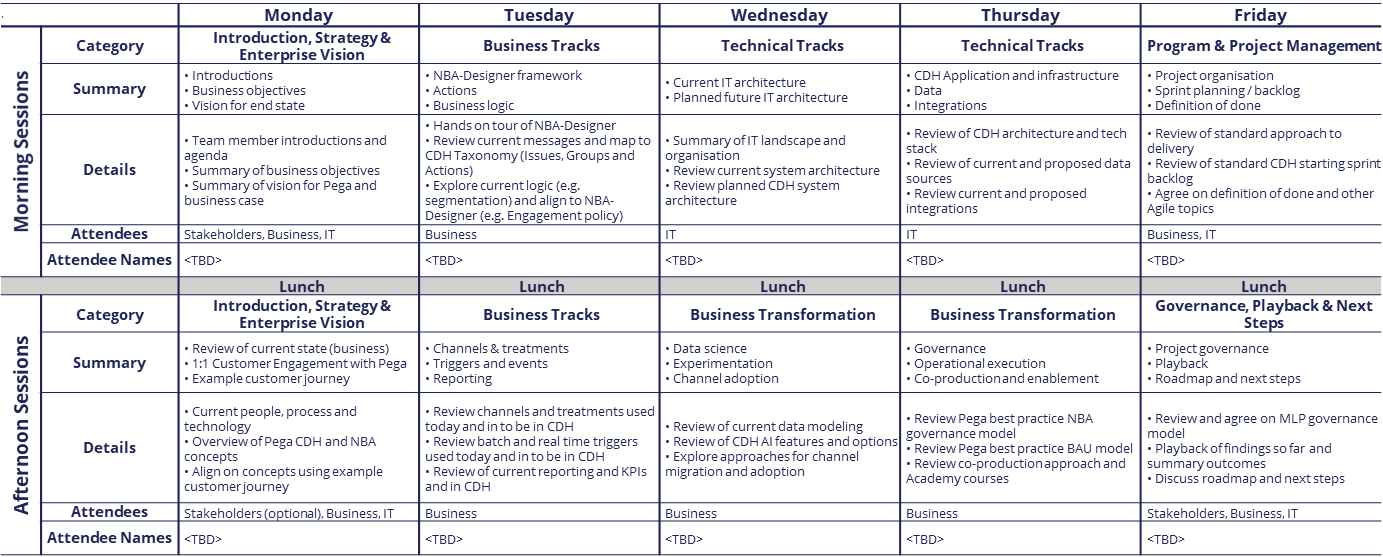This is the second blog in a series that describes how to implement the Pega Customer Decision Hub by following the Pega Express™ delivery approach end to end, and in the right way.
As I mentioned in my earlier post, when following the Pega Express delivery approach, Pega Customer Decision Hub projects consist of four phases: Discover, Prepare, Build, and Adopt.
In this post, I’ll describe the first phase: Discover.
In the Discover phase, the team verifies the selected scope and business outcomes. To do that in an exhaustive way, we developed an asset called the Solution Alignment Workshop (SAW).
The primary goal of the Solution Alignment Workshop is to ensure the client team understands what needs to be prepared in advance of the project kick-off. Understanding this is key to accomplishing a 10–12-week Minimum Lovable Product release and ensuring the future success of the Pega Next Best Action program.
During the Solution Alignment Workshop, the team will do the following:
- Confirm business goals and desired benefits. Ask yourself what success looks like. Be sure to align on the Minimum Lovable Product scope, including timelines, milestones, and measures of success.
- Identify how the Pega Customer Decision Hub interacts with other systems in the customer application architecture and identify, at a high level, the initial next best actions, channel integrations, data, reporting, business operations, and governance processes needed to support the Pega Customer Decision Hub program.
- Establish the high-level project plan, tasks, and milestones needed to accomplish the Minimum Lovable Product and to establish the roadmap and To-Be organization to support continuous growth of the program.
- Determine and identify the resources, roles, and responsibilities from within the client teams that are required to accomplish client-assigned tasks, and then determine the appropriate Pega training and enablement for them.
We would typically perform the workshop four to six weeks before the planned start of the project. This way, we can verify the scope, resources, and other prerequisites well before day one.
So, how do we perform this workshop? Typically, it is conducted by a small team of Pega consulting experts, or by one of our partners.
The team includes a Project Delivery Lead (for the project management and business benefits angle), and a Business Decisioning Architect and Technical Decisioning Architect (as functional and technical design authorities). The team is supported by stakeholders from the presales side.
A typical workshop schedule would look something like this:

The coronavirus pandemic has changed the way we work. We can now successfully run these workshops in a virtual way, ensuring high-quality output through an engaging and effective online approach. As businesses return to normal, we still have the option of conducting them face-to-face as well.
The goal of this exercise is not to reinvent the wheel or redefine (and change) all the good work you did to develop the program, business case, and roadmap, but rather to make sure handover from sales to delivery is performed correctly, meet the entry criteria for implementation, verify the predefined scope, and confirm the project logistics.
During this phase, you also need to make sure that all stakeholders, both on the project side, and within the organization, are informed and aligned on project objectives. A project typically includes deliverables on the project management side. These deliverables include a formalized project, sprint, and resource plan, as well as a detailed definition of functional, technical, and organizational deliverables.
Below, you’ll see an example template of a functional component diagram that shows the applications (Pega and external) in scope for the Minimum Lovable Product vs. future phases:

Another good example of a delivery lead would detail a standard Pega Customer Decision Hub project scope, but include deviations where needed (illustrated in orange):

Lastly, a detailed planning for the first Minimum Lovable Product, mapped to sprints and including testing and evaluation, should be created based on the standard template. It should look similar to the example below:

So, there you have it, an overview of how to perform the Discover phase properly, and which assets to use. In my next post, I will do a deep dive into the Prepare phase. I’ll discuss how to set up both the infrastructure and application, and how to start delivering value!
If you want to know more, keep following my blog series and take a look at the recommended resources for more detailed information on each of these topics.
In upcoming blogs we’ll continue to describe the changes that need to take place across people, processes, and technology for an organization to experience the incredible business benefits of a next-best-action engagement approach.
Recommended Resources:
-
Take this Pega Academy training to learn more about how to deliver a Pega Customer Decision Hub project successfully, and which assets are available through Pega.
-
Explore this module to learn more about Pega’s Customer Decision Hub Solution Alignment Workshop
-
View our webinar series, “The Ins and Outs of 1:1 Engagement” to learn how to connect conversations and build relationships.
-
Download the whitepaper, “Crossing the chasm: From campaigns to always-on marketing,” to learn how 1:1 marketing helps increase customer value.
-
Visit the Business Excellence page to access up-to-date reference materials on following best practices.
Don't Forget
-
JOIN THE CONVERSATION on Collaboration Center
-
FOLLOW @PegaDeveloper on Twitter
-
SUBSCRIBE to the Pega Developer Podcast on Spotify or via RSS

